


YOU ARE WISE ...
to choose a Modern GAS range because it will give you the best cooking results possible while adding new beauty and convenience to your kitchen. It is designed for long life and the easy care that is so necessary in today’s living.
The tips on range use and care can keep your range cooking perfectly and looking its best for years to come. This booklet is a collection of some of our most popular recipes. Each one has been carefully tested in our kitchen—we hope they’ll be favorites in your kitchen, too.
Call your GAS Company when necessary to check the temperature and to make any range adjustments. There is no charge for this service.
Please call me if I can help you. It is always a pleasure to talk with you about your GAS appliances.

Home Economist
YOUR GAS COMPANY
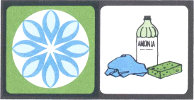
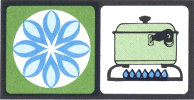
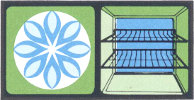
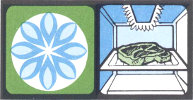
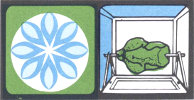
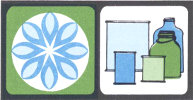
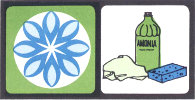
You will find that your Gas Range is as easy to care for as it is to use. The following suggestions will help keep it looking—and cooking—like new. Remember, good care means longer wear and maximum good service from any household appliance.
1. Use correct flame size. A flame which is too high will cause spattering and spillovers. Also, avoid overfilling utensils.
2. Before putting utensils into the oven or on a surface burner, be sure outside of pan is thoroughly clean.
3. Time cooking operations properly, and use CORRECT TEMPERATURES for roasting, baking and thermostatic top burner cooking. This will not only give you better cooking results, but also eliminate the possibility of spillovers and hard-to-clean pans.
4. A little care regularly keeps a range like new and is much easier than waiting until stains are cooked on and a major cleaning job is necessary. All surfaces can safely be washed with detergent and hot water. To retain the original appearance, RINSE and wipe surfaces dry after washing.
5. To keep the fine porcelain enamel and polished metal finishes free of scratches, avoid the use of gritty, harsh cleansers and abrasives which in time take away the shiny new finish.
6. If acid foods such as fruit juices, vinegar, coffee, tea or milk are spilled on the range, wipe them off immediately to guard against permanent discoloration of the finish.
7. Never place extremely hot utensils on the porcelain finished areas.
1. If there is a spillover when the range is warm, wipe off with a dry cloth or paper towel. After the range is cool, finish cleaning with warm water and a mild soap, or wash with a solution of 3 tablespoons baking soda dissolved in 1 quart of warm water. Rinse in clear warm water and dry with soft cloth.
2. Never scrape surfaces with a sharp object such as a knife or razor blade. In most cases, ordinary stains can be removed from the range with baking soda and a damp cloth. If the stain proves to be stubborn, use a mild cleanser such as Bon-Ami, Bab-O, or similar cleansers.
3. In most cases, a damp cloth will wipe the chrome surface clean. Use any one of the many good chrome cleaners if the stains prove to be stubborn.
4. All removable parts (except aluminum) will clean more easily if soaked in ammonia and hot water (4 tablespoons to 2 quarts) for a few hours.
5. If food spills over in the oven, sprinkle with salt to stop smoke and odor. Clean as soon as finished baking. Failure to do so may result in a permanently pitted surface.
Burners can be wiped off without removing them from the range. However, they are removable for an occasional thorough washing in a solution of detergent water. Remove stubborn spots with a damp cloth and baking soda. They may be placed in an inverted position in a warm oven to be dried. It is not necessary to boil burners. Be sure to fit burners securely back into place.
To clean top burner ports, use a pipe cleaner which has been dipped in ammonia or a wire, such as a straightened out paper clip rather than a toothpick which could break off and further clog the ports.
Cooking is carefree and accurate if the sensing device of the thermostatic top burner is kept clean. Simply wipe with a damp cloth or remove stubborn spots with SOAPLESS, fine steel wool. Generally the sensing devices do not lift out, however, there are exceptions. Refer to your range manufacturer’s manual for specific instructions.
Burner bowls, grids and drip trays can be removed for washing at the sink. Wash with mild detergent and hot water. If especially soiled, soak in a solution of hot ammonia water. Remove stubborn spots with a damp cloth and baking soda.
Burner control knobs are removable. Be sure control is in OFF position before removing knob. If knobs do not remove easily, slide a dish towel or cloth under the edge of the knob; encircle the knob and pull. Wash with mild detergent and hot water.
The oven interior and all removable parts clean much easier if a small dish of undiluted household ammonia is allowed to stand in it for several hours or overnight prior to washing. In most cases, cleaning can be completed with hot soapy water. Baking soda or a mild cleanser can be used on stubborn spots and stains. Soap filled steel wool pads may be used if well moistened and used gently.
Teflon-lined oven: Refer to range manufacturer’s instruction booklet.
Oven windows are not removable in most ranges. Wash in place with mild detergent and water or a solution of baking soda and water (3 tablespoons to 1 cup water).
Oven doors are removable on some ranges for easy cleaning. Also, once removed, access to the oven interior is easy. Refer to your range manufacturer’s manual regarding this feature.
The oven bottom and oven racks are easily removed for cleaning at the sink in mild detergent and water. If necessary, clean with fine steel wool pads, rinse well and wipe dry. Be sure to replace in correct position for even heat distribution.
A meat probe should not be immersed in water when cleaned. Wipe with a damp cloth.
A meat probe is a delicate instrument which should not be abused. When disconnecting the probe after cooking, grasp the plug on one end and the solid part of the probe on the other end. DO NOT PULL ON THE CABLE AT ANY TIME.
Also, the meat probe should not be stored in the oven or other parts of the range. Since the probe could become defective if it is exposed to 350 degrees or over, it should be stored at room temperature.
Broiler pan cleaning can be minimized by removing the broiler pan BEFORE preheating broiler compartment. Cold food placed on a hot broiler pan will stick before it is placed in the broiler. After food is cooked, remove it AND the broiler pan from broiler compartment. Drippings will bake on the broiler pan if left in a hot broiler compartment. As soon as food has been removed from the broiler pan pour off grease. Sprinkle pan and insert with soap powder or liquid detergent and cover with a hot damp cloth or wet paper towels. Drippings will steam and loosen while the meal is being served. A soapy fine steel wool pad may also be used if needed. Do not cover broiler pan insert with aluminum foil during broiling. Grease MUST be allowed to drip through the broiler pan insert into the lower pan away from the heat.

Rotisserie with burner above food: Use broiler pan without insert as a drip pan. Keep at least ½ inch of water in pan to eliminate spattering of basting sauces and to aid cleaning.
Rotisserie with indirect heat from oven burner: Water in the rotisserie pan is not recommended when using this type rotisserie. Since the water is between the food and the burner—there is too much steaming. Instead, crumple aluminum foil and place in rotisserie pan to catch drippings and help reduce spattering.
To keep a gleaming griddle, turn off the flame when cooking is finished and wipe the surface with paper towels. When cool, wash with hot soapy water (not synthetic detergent), rinse and dry thoroughly. Avoid using a soda or alkaline cleaner.
To preserve the finish of the griddle never scrape it with knives or other sharp objects.
Overheating or sudden temperature changes can damage a griddle.
Teflon: Refer to manufacturer’s instructions.
If oven light needs replacing, buy a 40 watt Heat Resistant lamp (not an ordinary light bulb). Turn light switch to OFF position, cover old lamp with a dry cloth and unscrew; replace with new one. When cleaning, do not touch hot lamp with a wet cloth; it may break.
| MATERIAL OR FINISH | RANGE PART | TO REMOVE SOIL |
|---|---|---|
| Porcelain Enamel | Cook Top Door and Side Panels Burner Grids Burner Bowls | Detergent OR baking soda (3 Tbsp. to 1 qt. water) and hot water |
| Oven Interiors Broiler Pan | Detergent OR ammonia and hot water | |
| Broiler Compartment Interior | Soap filled steel wool pad with plenty of water | |
| Oven Racks and Guides | Ammonia Solution (½ C. to 1 gal. water) | |
| Chrome | Burner Bowls Oven Interior Handles | Detergent and hot water or chrome polish |
| Aluminum | Burner Caps Trim | Detergent and hot water, soapy fine steel wool pad, or aluminum cleaner. Dry aluminum parts fairly rapidly. To prevent darkening, do not soak. |
| Glass, Plastic and Enamel Paint | Back Panel Oven Window Burner Control Knob Range Bottom | Detergent and hot water only; rinse well and polish dry. |
| Stainless Steel or Brushed Chrome | Doors Range Tops | Full strength ammonia OR full strength liquid all-purpose cleaner with ammonia; rinse well and polish dry. |
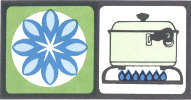
Gas burners provide a thousand and one shades of heat from high to very low to suit every cooking need. Heat is supplied instantly, and there is no leftover heat when the burner is turned off. To use the burner, turn the burner control until the burner ignites; then turn to adjust the flame size. Some burners have audible “clicks” to indicate heat settings.
Correct flame size is determined by pan size, pan material, what you are cooking and whether you are cooking with liquid. Even when cooking in a liquid or with a pan which conducts heat well, you may want to lower the flame to adjust for pan size (see sketch below). The flame should never extend beyond the outer edge of the utensil. Any higher flame is wasted heat.
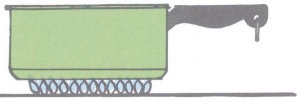
For all cooking in aluminum utensils or for cooking in liquid in other utensils, adjust the flame so it touches the pan about ½ inch from the outer edge.
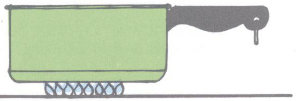
For non-aluminum pans (unless you are cooking in liquid) adjust the flame so it is about half the diameter of the pan.
Foods cook just as quickly at a gentle boil as at a rapid rolling boil—in both cases the water temperature is 212 degrees. A high boil is used only to bring food to the boiling point; then lower the flame and finish cooking with a minimum flame.
EXCESS HEAT RESULTS IN HARD-TO-CLEAN GREASE AND STEAM DEPOSITS ON WALLS, CABINETS AND CEILINGS. WHILE THE FUEL IS OFTEN BLAMED FOR SUCH DIRT, THE REAL PROBLEM IS TOO MUCH HEAT AND/OR FAILURE TO COVER UTENSILS WHENEVER POSSIBLE.
For instant heat needed to bring foods to a rapid boil.
To brown and fry food.
To maintain gentle boil for boiling or steaming, cream sauces, gravies, puddings, etc.
To keep foods hot without additional cooking; melting and keeping hot beverages at serving temperature. Always cover utensils with this setting.
Of all its advantages, the cleanliness of GAS is perhaps the greatest. A properly adjusted Gas flame is one of the cleanest energy sources known.
The color of the flame is the key to proper burner adjustment. A good flame is clear and blue and hardly visible in a well lighted room. Each cone of flame should be steady and sharply defined.

Cooking is easier with the correct pan; a well designed pan. Look for these characteristics when selecting new pans:
aids even heating and ease of use. The pan should set level with or without food.
helps to retain moisture, flavor and nutrients during the cooking process. It keeps temperature in the pan more even and holds in heat, aroma, and steam. Cover pans whenever you can so foods cook with maximum speed and minimum clean-up. Cooking with a cover will require a lower flame setting than will be needed for the same food cooked uncovered.
aids in easy handling of the utensil and avoids discomfort or burn.
aids in retaining the original shape of the pan to insure good lid fit and ease in cleaning.
insures more even heating of the pan and more even browning or cooking. Examples of good heat conducting materials are: aluminum or aluminum-clad stainless steel. Materials which conduct heat slowly (stainless steel, cast iron, glass and enamel) may require special attention for desired results. GENERALLY, LOWER FLAME HEIGHTS ARE BEST FOR NON-ALUMINUM UTENSILS.
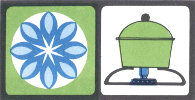
This new flexible control permits you to cook automatically in utensils of many types and sizes. Temperature is thermostatically controlled by a sensing device in the center of the burner. The sensing device, in contact with the pan bottom, transmits food temperature to a thermostat which maintains any degree of heat you select, automatically.
The flame size control is an added convenience to permit easy adjustment of the height of the flame on the burner. The size of flame should be selected to fit the size or type of cooking utensil, or the kind of food or cooking to be done. A low size flame is best for small utensils, for non-aluminum pans (stainless steel, cast iron, glass and enamel), and foods requiring a temperature of 200 degrees or below.
Some thermostatic top burners are available which can be set to cook at any temperature, then AUTOMATICALLY reduce to a holding temperature. For details, refer to manufacturer’s instruction booklet.
1. Food is better because each food can be cooked at the most desirable, accurate temperature.
2. Cooking is more carefree because the temperature selected is maintained automatically. Burning, scorching, boil-overs and pot-watching are eliminated.
3. After cooking the food can be held on the “LOW” setting when there are unavoidable delays at serving time. Even mashed potatoes will stay hot and fluffy without scorching!
4. Results are excellent when doing special types of cooking such as deep fat frying, griddle cooking, warming leftovers, popcorn, skillet meals, and sensitive foods such as custards and cream sauces because it assures even, accurate temperature control.
1. Use flat bottomed utensils which make good contact with the sensing device. Try also to choose pans that fit the quantity of food you are cooking. Utensils perform best when nearly full.
2. Aluminum conducts heat very well and is ideal for use on the thermostatic top burner.
3. Do not use glass utensils unless food is cooked in liquid.
4. The top of the sensing device and the bottom of the utensil should be kept clean.
5. In frying foods, particularly meats, make certain that the center of the pan over the sensing device is covered with food.
6. Generally, lower flame heights are best for non-aluminum utensils.
7. When meats with bones are pan broiled and insufficient fat is obtained 13 from the meat, it may be necessary to add a small amount of shortening to insure good contact between pan and meat.
8. Frying in pyroceram (Corningware) requires low flame size and 25 to 50 degrees lower temperature.
9. When cakes, breads or desserts are baked on the thermostatic top burner, the top of the food has a slightly steamed appearance. Remove cover for last 5 minutes to allow food to dry on top.
10. Preheating is necessary when pan frying, deep fat frying, pan broiling and griddle cooking. Put the shortening in the pan (except for pan broiling) and set the thermostatic control at the flame size and temperature recommended for the food being cooked. When the temperature is reached, the flame will automatically lower or diminish completely and you can begin to fry then or whenever you are ready. The burner will automatically increase or decrease the flame as needed to maintain the selected temperature.
11. Tight-fitting lids keep heat, moisture and flavor inside the pan and should be used for warming, melting, simmering, steaming and most boiling. Cooking without a cover will require a higher temperature setting than will be needed for the same food cooked covered. Frying and pan broiling do not require covers.
12. It may be helpful to record the temperature settings which give you the best results.
Personal taste, the quantity of food and other factors may necessitate a slightly higher or lower temperature. Reduce flame size for all small utensils before selecting temperature and for nonaluminum pans (stainless steel, cast iron, glass and enamel). To fry in pyroceram (Corningware) utensils, lower temperature 25 degrees to 50 degrees.
ALUMINUM IS THE BEST HEAT CONDUCTOR AND IS IDEAL FOR USE ON THERMOSTATIC TOP BURNER.
| CONTROL SETTING | |||||
|---|---|---|---|---|---|
| FOOD | TEMPERATURE | APPROXIMATE COOKING TIME | |||
| BEVERAGES | |||||
| Cocoa | 175°-200° | 10 to 15 Min. | |||
| Coffee | |||||
| Percolator | 225°-250° | 12 to 15 Min. | |||
| Vacuum | 185° | 8 to 10 Min. | |||
| To Keep Warm | 150°-175° | ||||
| BREADS | |||||
| Grilled Sandwiches | 325°-350° | 2 to 3 Min. per side | |||
| French Toast | 325°-350° | 3 to 4 Min. per side | |||
| Pancakes | 350°-375° | 1 to 3 Min. per side | |||
| CAKES | |||||
| (Bake in 10-inch skillet, covered) | |||||
| Gingerbread | 250° | 30 to 35 Min. | |||
| Package Cake, 1 layer | 250° | 25 to 30 Min. | |||
| Pineapple Upside-down Cake, 1 layer | 250° | 25 to 30 Min. | |||
| CANDY | |||||
| (Use a heavy pan, preferably aluminum) | |||||
| Fudge | 250° | To soft ball stage on candy thermometer | |||
| Divinity | 250° | To hard ball stage on candy thermometer | |||
| Peanut Brittle | 325°-350° | 15 to 20 Min. or hard cracked stage on candy thermometer | |||
| CEREAL | |||||
| (added to boiling water) | |||||
| Cream of Wheat (quick) | 175°-200° | 5 Min. | |||
| Oatmeal (quick) | 175°-200° | 3 to 5 Min. | |||
| Macaroni, Spaghetti and Noodles | 225°-250° | Until tender | |||
| Rice | 210°-225° | 20 Min. | |||
| DESSERTS | |||||
| Custards: | |||||
| Soft (stirred) | 175°-190° | 4 to 7 Min. | |||
| Steamed, individual | 175°-190° | 20 to 30 Min. | |||
| Puddings: | |||||
| Cream Pie Filling | 200°-210° | 6 to 8 Min. | |||
| Package Mix | 200° | 4 to 8 Min. | |||
| Steamed, 1-qt. mold | 200° | According to recipe | |||
| Tapioca | 200° | 5 to 8 Min. | |||
| EGGS | |||||
| Fried | 200°-225° | 2 to 4 Min. preheated skillet | |||
| Omelet | 250°-300° | 3 to 5 Min. | |||
| Poached | 175°-200° | 3 to 7 Min., covered | |||
| Hard Cooked | 200° | 20 Min., covered | |||
| Soft Cooked | |||||
| (Added to boiling water) | 200°-225° | 3 to 6 Min. | |||
| Scrambled | 200°-225° | 2 to 4 Min. preheated skillet | |||
| FRUITS | |||||
| Applesauce | 200° | 15 to 20 Min., covered | |||
| Cranberry Sauce | 225° | 15 to 20 Min. | |||
| Dried Fruits, 1 lb. | 190°-200° | 15 to 35 Min. | |||
| FROSTINGS | |||||
| (Use heavy pan, preferably aluminum) | |||||
| Boiled | 250°-275° | 8 to 10 Min. or long thread | |||
| Fudge or Caramel | 250°-275° | 12 to 14 Min. or soft ball | |||
| Seven Minute | 190°-200° | 3 to 10 Min. | |||
| JAM AND JELLY | |||||
| Jam, 3 to 4 lb., fruit | 225° | According to recipe | |||
| Jelly, 2 cups juice | 250° | Until jelly “sheets″ | |||
| FISH, MEAT AND POULTRY | |||||
| Bacon (do not preheat pan) | 300°-325° | 3 to 5 Min. per side | |||
| Braised Meat | 350° | Until brown | |||
| 210° | Until tender | ||||
| Canadian Bacon | 275°-300° | 2 to 5 Min. per side | |||
| Chicken, cut up | 325° | Until brown | |||
| 210°-225° | 20 to 40 Min., covered | ||||
| Fish Fillets | 325° | 4 to 5 Min. per side | |||
| Ground Beef Patties | 300°-325° | 4 to 6 Min. per side | |||
| Ham Slice, ¼″ to ½″ thick | 300° | 6 to 8 Min. per side | |||
| Liver, ¼″ to ½″ thick | 275° | 3 to 5 Min. per side | |||
| Pork Chops, ½″ to 1″ thick | 275° | Until brown | |||
| 200° | 20 to 40 Min., covered | ||||
| Pork Sausage | 275° | Until thoroughly cooked | |||
| Pot Roast, 3 to 5 lb. | 325° | Until brown | |||
| 200°-215° | 3 to 4 Hr., covered | ||||
| Steak, Cube | 350° | 2 Min. per side for medium doneness | |||
| Steak, Sirloin, Club, T-Bone or Rib ½″ to ¾″ thick | 325° | 3 to 7 Min. per side for medium doneness | |||
| SAUCES | |||||
| (Cook uncovered, stirring constantly) | |||||
| Barbecue Sauce | 210° | 15 Min. | |||
| Gravy | 200°-225° | 5 to 8 Min. | |||
| White Sauce | 200°-210° | 4 to 6 Min. | |||
| SOUPS | |||||
| (Cook covered, stirring occasionally) | |||||
| Heating creamed soups | 200° | 8 to 10 Min. | |||
| Vegetable | 210° | 2 to 3 Hr. | |||
| VEGETABLES | |||||
| Fresh or frozen | 210°-225° | Until tender, covered | |||
| Potatoes: | |||||
| Baked | 375° | 1 to 1½ hrs., on rack in covered aluminum pan | |||
| Hash Brown | 325° | Until brown | |||
| Sweet Potatoes (candied) | 225°-235° | 10 to 20 Min. | |||
| SPECIAL COOKING OPERATIONS | See directions on following pages | ||||
| DEEP FAT FRYING | |||||
| Shrimp, Oysters, etc. | 375°-400° | 2 to 6 Min. | |||
| Doughnuts, Fritters | 375°-400° | 3 to 6 Min. | |||
| Onion Rings | 375°-400° | 6 to 7 Min. | |||
| Potatoes | 375°-400° | 6 to 10 Min. | |||
| MISCELLANEOUS | |||||
| Melting Chocolate, Cheese, Butter | 175° | 7 to 9 Min., covered metal pan | |||
| Popcorn | 375° | 3 to 6 Min. | |||
| Pressure Cooking | Follow manufacturer’s instructions | ||||
| 225°-235° | 5 lb. pressure | ||||
| 235°-240° | 10 lb. pressure | ||||
| 240°-250° | 15 lb. pressure | ||||
| WARMING | |||||
| Baby Bottle | Low to 150° | Until warm | |||
| Leftovers | 150°-175° | 10 to 20 Min., covered pan | |||
| Rolls, wrapped in foil on rack | 250° | 15 to 20 Min., covered aluminum pan | |||
| To convert a favorite recipe to Burner-with-a-Brain cooking—if the recipe says: | ||
|---|---|---|
| Warm or melt | use | 150°-175° or Low |
| Simmer or low | use | 175°-200° |
| Boil | use | 200°-225° |
| High boil | use | 225°-250° |
| Fry | use | 250°-375° |
| Deep fat fry | use | 375°-400° |
For a simple but delicious dessert, toast slices of pound cake. Preheat griddle on the thermostatic top burner at 300 degrees. Cut slices of pound cake one inch thick; butter both sides or leave plain, depending on your flavor preference. When flame lowers, grill on hot griddle for about 3 minutes per side or until nicely browned. Serve plain or topped with ice cream and/or sauce.

Wrap rolls or muffins in double thickness of aluminum foil, folding edges under tightly. Place foil wrapped package on rack or crumpled aluminum foil in aluminum skillet or saucepan on thermostatic top burner at 250 degrees for 15 to 20 minutes or until heated through.
Place eggs and water in pan. Cover with tight fitting lid. Cook on thermostatic top burner at 200 degrees for 20 minutes. Remove from flame, pour off hot water and immediately cool with cold water. Peel immediately or refrigerate, peeling later. This method of preparation eliminates pot watching, cracked eggs and dark ring around yolks.
Wash and core 6 baking apples. Add a dash of cinnamon, one Tbsp. sugar and a dot of butter to each apple. Place apples in skillet or saucepan. Add one Tbsp. water for each apple to be cooked. Cover and cook on thermostatic top burner at 212 degrees for 15 to 20 minutes. Spoon sauce in bottom of skillet over each apple before serving.
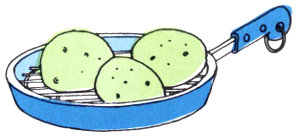
Place scrubbed potatoes on a rack or on crumpled aluminum foil in aluminum skillet or saucepan. Do not add water or wrap potatoes in foil. Cover skillet or saucepan and bake on thermostatic top burner at 375 degrees until done, about 1 to 1½ hours.
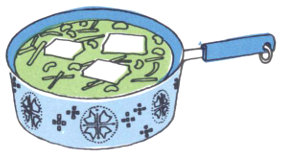
Break up frozen vegetable by pounding package against edge of counter. Place vegetable in saucepan with 2 to 3 tablespoons butter and ½ teaspoon salt. For starchy vegetables like lima beans and corn, 1 or 2 tablespoons of water may be needed. Cook on thermostatic top burner at 210 degrees. Cook time indicated on package plus 5 minutes.
NOTE: To prevent breaking spears of asparagus and broccoli, thaw just enough to break apart.
For 3 cups of cooked white rice, place 1 cup uncooked rice, 2 cups water and 1 teaspoon salt in 2-qt. saucepan. Place on thermostatic top burner at 225 degrees. Bring to a boil, then cover pan, lower temperature setting to 190 degrees, and simmer about 15 minutes or until water is absorbed and rice is tender. For extra fluffy rice, turn burner off and let rice stand, covered for 10 minutes more.
Brown and wild rice are best cooked this way also, but cooking time will be much longer—about 35 to 45 minutes total cooking time. Also, add about ½ cup more water.

Place 2 tablespoons of oil and ½ cup popcorn in 10-inch aluminum skillet or saucepan. Cover tightly and place on thermostatic top burner at 375 degrees. Heat until popping stops, about 3 minutes. No need to shake the pan. Pour into serving bowl and toss with melted butter and salt.
Pressure cooking is extremely easy with a thermostatic top burner. The following temperatures may be used as a guide: 240° to 250° for 15 pounds pressure, 235° to 240° for 10 pounds, and 225° to 235° for 5 pounds. Use medium flame if the pressure saucepan is of non-aluminum material. Raise or lower the temperature if needed to maintain the correct pressure; once it is determined, record it for future use. Time pressure cooking from the time the desired pressure is reached.
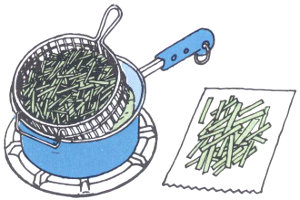
Accurate top burner temperature control makes deep fat frying just as easy as boiling water. Use a deep aluminum skillet or French fryer so oil will only half fill it and completely cover food. Preheat oil at recommended temperature (usually 375 to 400 degrees) until flame lowers, about 10 minutes. Add food in small amounts, cook until brown, turning once. Remove and drain on absorbent paper.
Set thermostatic top burner at 275 to 350 degrees depending on kind of meat and thickness. Preheat the griddle or skillet until the flame reduces. Rub pan lightly with a bit of meat fat. Brown meat on both sides. Do not cover. Do not add water. Pour off fat as it accumulates in pan. Turn meat occasionally so that it cooks evenly. Season and serve.
Brown ham slice on both sides in butter in large skillet. Add potatoes, green beans, onion, salt, pepper and water. Cover and place on thermostatic top burner at 215 degrees for 30 minutes. Makes 4 servings.
Prepare cake mix according to directions on package. Combine butter and brown sugar in 10-inch skillet; heat enough to melt and blend together. Arrange apple slices and maraschino cherries on sugar mixture. Spread cake batter over fruit. Cover skillet. Cook on thermostatic top burner at 250 degrees for 25 minutes. Uncover; allow to cook 5 minutes longer. Cool 2 to 3 minutes. Loosen sides and invert on platter, allowing pan to remain in position for 1 minute. Remove pan and serve. Makes 6 to 8 servings.
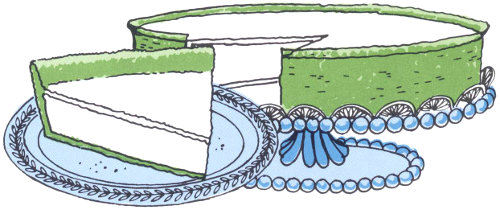
Cut two double thickness strips of aluminum foil 18 × 3 inches. Place crosswise over bottom and up side of 10-inch skillet, extending about an inch above rim of skillet. Cut a circle of foil to fit bottom of skillet and lay over foil strips. Grease foil and sides of skillet. Mix graham cracker crumbs and cinnamon. Cut in butter. Press mixture on bottom and about 2 inches up sides of skillet. Soften cream cheese, add cream and beat until smooth. Add combined sugar, flour and salt; blend. Add unbeaten egg yolks, vanilla extract and lemon peel; mix well. Beat egg whites to soft peak stage and fold into cheese mixture. Pour into crumb-lined pan and place on thermostatic top burner at medium flame and 235 degrees. Cover tightly and bake for one hour. Turn burner off and let cake stand one hour. Refrigerate covered, for 3 to 4 hours. Carefully lift cake from pan, using foil strips and transfer to serving plate. Trim off excess foil or pull strips carefully from underneath the cake. Spoon Festive Raspberry Sauce over individual servings if desired. Makes 10 to 12 servings.
NOTE: At the end of the cooking time this cheese cake will be very soft in the center. After 3 to 4 hours refrigeration, the cake will be firm enough to cut.

Drain raspberries; reserve sirup. Combine sugar and cornstarch; add to reserved sirup in saucepan. Cook and stir on thermostatic top burner at medium flame and 212 degrees until mixture comes to a boil and thickens; cool. Add raspberries; refrigerate. When chilled, spoon raspberry sauce over cheese cake.
Mix sugar, butter, salt and milk in a 10-inch skillet. Place over thermostatic top burner at 300 degrees. Bring mixture to a boil, stirring until sugar is dissolved. Continue stirring and allow to boil 4 to 5 minutes. Turn burner off. Add marshmallows, chocolate, nuts and vanilla; stir until marshmallows and chocolate are completely melted and smoothly blended. Place in a buttered 8-inch square pan, spreading evenly. Cool before cutting into squares. Makes approximately 2 pounds.

One type of griddle is designed by the range manufacturer to fit over one of the surface burners. It can usually be converted to a fifth burner and is often thermostatically controlled. The other type is a portable separate utensil which fits over any range burner.
The griddle should be seasoned before using for the first time. To do this, brush surface with unsalted shortening. Heat on thermostatic top burner at 325 degrees for 15 minutes. Turn flame off and allow griddle to cool. While griddle is still warm, wipe off excess shortening with paper towel. The griddle is now ready for use.
The recommended thermostatic controlled burner temperature or a medium flame should be used when grilling foods. If griddle has no temperature indicator or is not thermostatically controlled, use a few drops of water as a test for proper cooking temperature. The water will form beads and “dance” when the griddle is ready to use.
Preheat griddle at high flame and recommended temperature. Rub griddle lightly with a bit of meat fat.
| FOOD | THICKNESS | TEMPERATURE | TOTAL TIME | |
|---|---|---|---|---|
| BEEF: | ||||
| Club, T-Bone, Rib, Sirloin Steaks | ¾″ | 325°-350° | 12-14 min. for medium | |
| Cube Steaks | ¼″ | 350°-375° | 4-6 min. for medium | |
| Ground Beef Patties | ½″ to 1″ | 300°-325° | 8-12 min. for medium | |
| EGGS | 300° | 2-4 min. | ||
| FRENCH TOAST | 350°-375° | 2-3 min. | ||
| LAMB CHOPS | ½″ to ¾″ | 300°-350° | 16-20 min. | |
| PANCAKES | 375°-400° | 3-4 min. | ||
| PORK: | ||||
| [a]Bacon | ⅛″ | 300°-325° | 6-10 min. | |
| Canadian Bacon | ⅛″ | 275°-300° | 4-6 min. | |
| Ham Slice | ½″ | 275°-300° | 10-14 min. | |
| [a]Sausage Patties | ½″ | 275°-300° | 12-14 min. | |

The oven should be allowed to preheat 10 to 15 minutes for most baking and all roasting operations.
Arrange pans 1½ inches from sides of oven and from each other for best heat circulation. There should also be 1½ inches of air space above and below each pan.
It is possible to use both racks at the same time in a Gas oven and still be assured of even browning. Two sheets of cookies or 4 layers of cake can be baked without shifting the pans. When using two racks and several pans, stagger the pans so no pan is squarely above another.
The most desirable baking results are obtained when the correct pan is used. Use the size pan recommended in the recipe. Use a medium weight aluminum or glass cake pan. Do not expect warped or darkened pans to produce even browning or a level product.
If food runs over in the oven, sprinkle with salt to stop smoking. Clean as soon as baking has been completed and oven has cooled.
Use minute timer to remind you when to check foods.
With a window in the door and an interior oven light, the cooking progress may be checked without opening the door. Leave oven door closed at least until the minimum baking time has elapsed.
When baking in glass pans, lower recommended temperature 25 degrees and use the recommended time.
For mixes, packaged and frozen foods, follow label directions. Remember, however, that cooking times are approximate and can be adjusted to suit personal preferences.
The non-tip oven rack may be pulled out for loading and unloading the oven without reaching into the heated oven.
Oven meals requiring same time and temperature for all foods have been planned on the following pages. Your own favorite recipes can also be cooked and held automatically with the new programmed system.
If aluminum foil is used in the oven, place a small sheet in the center of the oven bottom. The heated air MUST be allowed to circulate freely through the openings toward the outer edge of the 23 oven bottom. DO NOT completely cover the oven bottom. DO NOT cover an oven rack with foil. Use aluminum foil only when absolutely necessary. DO NOT leave foil in the oven permanently. If these instructions are not followed, damage to the range and unsatisfactory baking results can be expected.
A meat probe is a device for measuring, indicating and/or controlling internal temperature of meats by means of a metal probe inserted into the roast and linked to an indicator or actuator. This convenience feature eliminates guesswork and insures perfection every time.
Wipe meat with a clean, damp cloth. Season and place, fat side up, on rack in shallow roasting pan. Basting is not necessary.
When inserting probe into meat, put center section of probe into the lean center muscle away from bone and fat and as near the center of the meat as possible. When in use, the meat probe tip should be INSIDE the meat, not sticking through the meat and out the other side.
Always make certain the full length of probe is inserted in the meat. This may mean the probe will be inserted at an angle to have tip in center of muscle.
Plug other end of cable into socket in oven wall.
Turn selector dial to desired degree of doneness.
Set oven thermostat to 325 degrees.
DO NOT put an aluminum foil cover on meat when probe is used.
When roasting is completed, the control automatically signals, turns the oven off and/or reduces to and maintains a keep-warm temperature, depending on the type of thermometer.
Refer to manufacturer’s instruction booklet for further information.
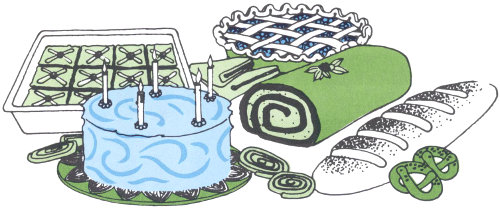
| Cut | Approx. Minutes Per Pound (3 to 5 lbs.) | Approx. Minutes Per Pound (5 to 8 lbs.) | Meat Thermometer Reading When Done (degrees F.) | ||
|---|---|---|---|---|---|
| BEEF | |||||
| Rolled Rib | |||||
| Rare | 31-36 | 27-30 | 140 | ||
| Medium | 36-40 | 32-35 | 160 | ||
| Well-done | 40-45 | 38-40 | 170 | ||
| Standing Rib | |||||
| Rare | 21-26 | 17-22 | 140 | ||
| Medium | 26-30 | 22-26 | 160 | ||
| Well-done | 30-35 | 28-33 | 170 | ||
| VEAL | |||||
| Leg | 35-40 | 30 | 170 | ||
| Loin | 35 | 30 | 170 | ||
| Shoulder (boned and rolled) | 45 | 40 | 170 | ||
| LAMB | |||||
| Leg | |||||
| Medium | 35 | 30 | 175 | ||
| Well-done | 40 | 35 | 182 | ||
| Shoulder (bone in) | 30-35 | 182 | |||
| Shoulder (boned and rolled) | 40 | 182 | |||
| FRESH PORK | |||||
| Rib and Loin | 35-40 | 35 | 170 | ||
| Shoulder, Picnic | 40 | 35-40 | 185 | ||
| Shoulder, Butt | 50-55 | 185 | |||
| Fresh Ham, Whole (10-14 lbs.) | 35-40 | 185 | |||
| Cut | Minutes Per Pound | Meat Thermometer Reading When Done (degrees F.) | |||
| SMOKED HAM (Mild Cure) | |||||
| 15 lbs. and over | 20 | 160 | |||
| 12-15 lbs. | 21-22 | 160 | |||
| 10-12 lbs. | 23-24 | 160 | |||
| Under 10 lbs | 25-26 | 160 | |||
| Half Hams (5-8 lbs.) | 26-28 | 160 | |||
| Picnic Shoulder | 30-35 | 170 | |||
| Cottage Roll | 35-40 | 170 | |||
Place breast-side up on rack in shallow pan. Brush skin with fat or cover with fat-moistened cloth.
| Ready-to-Cook Weight (pounds) | Oven Temperature | Approx. Roasting Time Stuffed (Hours) | ||
|---|---|---|---|---|
| CHICKEN | 1½-2½ | 325 | 1¼-2 | |
| 2½-3½ | 325 | 2-3 | ||
| 3½-4¾ | 325 | 3-3½ | ||
| TURKEY (Note: Unstuffed birds require 5 min. less time per lb.) | ||||
| 6-8 | 325 | 3-3½ | ||
| 8-12 | 325 | 3½-4½ | ||
| 12-16 | 325 | 4½-5½ | ||
| 16-20 | 325 | 5½-6½ | ||
| 20-24 | 325 | 6½-7 | ||
Combine milk, potatoes, shortening, 1 C. flour, sugar and salt in large mixing bowl; let stand until lukewarm. Add yeast softened in lukewarm water; add eggs. Let stand 1 hour. Stir and add 4½ to 5 C. flour to make a slightly stiff dough. Knead until smooth on lightly floured surface. Return to greased mixing bowl. Let rise about 1 hour or until doubled in bulk. Shape desired number of rolls; place on greased baking sheet; let rise 1 to 1¼ hours or until doubled in bulk. Bake in Gas oven at 425 degrees 10 to 12 minutes. Makes 3 dozen medium-sized rolls.
NOTE: Punch down unused dough, cover and place in refrigerator until ready to use.
Use enough Potato Roll dough to roll into 12 × 6 inches rectangle, ¼-inch thick. Spread with mixture of ¼ C. melted butter, ¼ C. brown sugar, 1 tsp. cinnamon and ¼ C. chopped pecans. Roll as for jelly roll, cut into 9 slices. Butter a 9-inch square baking dish and pour in ¼ C. light corn sirup. Place rolls, cut side up, in dish. Let rise 1 to 1½ hours or until doubled in bulk. Bake in Gas oven at 425 degrees 12 to 15 minutes. Makes 9 rolls.
Sift together flour, salt, soda and baking powder. Cut in shortening with pastry blender or two knives until mixture resembles coarse corn meal. Stir in ¾ C. milk. Add enough more milk to make dough light and soft but not sticky. Turn out on lightly floured board or pastry cloth. Knead gently about 6 times. Roll dough to ½-inch thickness. Cut with floured biscuit cutter. Place on ungreased baking sheet. Bake in Gas oven at 450 degrees 10 to 12 minutes. Makes about 12 2-inch biscuits.
Cream shortening and sugar. Add beaten eggs and lemon peel. Sift flour, baking powder and salt together and add alternately with milk. Fold in nuts. Pour into greased and floured 8½ × 4½ × 2½-inch loaf pan. Bake in Gas oven at 350 degrees for 1 hour or until done and lightly browned on top. Remove from oven and let cool in pan 15 minutes. Dissolve ⅓ cup sugar in lemon juice. Pour over bread. Let stand for 10 minutes. Remove bread from pan and cool. This is an excellent bread to use for buttered tea sandwiches.
Sift flour and salt into bowl. Remove ⅓ C. flour mixture and combine with water to form paste. Cut shortening into remaining flour until pieces are the size of peas. Add paste to shortening-flour mixture. Mix and shape into ball. For each crust, place half the pastry on floured board or pastry cloth. Roll ⅛-inch thick with short, light strokes from center out, keeping it circular in shape. Makes 2 nine-inch crusts.
Note: For baked shell: 450 degrees for 10 to 12 minutes.

Combine ¾ C. sugar with flour, cornstarch and salt in saucepan. Slowly add boiling water, stirring constantly to keep smooth. Cook on thermostatic top burner at 200 degrees, stirring constantly, until smooth and thick enough to mound when dropped from spoon. Reduce temperature to 190 degrees; cover and cook 15 minutes. Beat egg yolks with ¼ C. sugar; gradually stir hot filling into egg yolk mixture. Return to pan and continue to cook for 5 minutes, stirring occasionally. Add lemon juice and peel; mix well. Pour into pie shell.
Beat egg whites with cream of tartar until frothy. Gradually beat in sugar, a little at a time. Continue beating until stiff and glossy. Blend in vanilla extract. Pile meringue onto pie filling, being careful to seal the meringue to edge of crust to prevent shrinking. Bake in Gas oven at 350 degrees for 12 to 15 minutes. Cool gradually, away from drafts.
Cream butter and sugar. Add egg; mix well. Add flour and vanilla; blend. Spread dough to ½-inch thickness on a 17 × 14-inch greased cooky sheet or in a 15½ × 10½-inch jelly roll pan. Spread with melted chocolate. Sprinkle nuts over top and press into chocolate. Bake in Gas oven at 375 degrees for 15 to 20 minutes. Score while still warm. When cool, cut and remove from cooky sheet. Makes approximately 4 dozen cookies.

Your new Gas range has a new type of oven thermostat that provides low-temperature heat control from 140° to 225°. This new feature has miraculously opened up a new temperature area with many special uses. See pages 30 and 31 to see how this control will help you!
You will notice the following characteristics with the new low-temperature oven control:
1. After turning the oven control to the desired temperature, there will be a slight delay (several seconds) before the oven burner comes on.
2. The oven burner turns on and off as the oven operates except at the “Broil” setting. Baking times and temperatures are not affected by the “off-on” control.
When using temperatures below 225°, preheating is generally recommended. To preheat, just turn the control to the temperature you want. It is not necessary to turn it first to a higher setting. Allow 10 minutes for preheating.
Many ranges have the special feature of programmed cooking which reduces the cooking temperature to the keep-warm setting automatically. However, there are two ways to cool the oven manually to a lower holding temperature:
1. The quickest method is to turn the oven control to the desired low-temperature setting and open the oven door for 10 to 15 minutes to allow excess heat to escape. Then close the door until ready to serve the food.
2. A second method of cooling is to turn the oven control to the lower setting about 15 minutes before the end of the usual cooking time for the food you are preparing. Let the oven cool with the door closed. As the oven cools gradually to the keep-warm temperature, the food will finish cooking. If the oven door is opened during this cool down period (approximately 45 minutes after you lower the temperature) additional cooking time may be needed.
The setting recommended for the main course is usually a good compromise if all the foods in a meal do not have the same recommended keep-warm temperature.
Moist foods should be tightly covered; many foods need only a loose cover. Aluminum foil makes an ideal cover if the utensil has no lid.
Generally it is best to wait until just before serving to carve meats—especially rare or medium meats. However, if you do wish to carve meats ahead of time, keep the exposed cut surfaces close together and cover lightly with dampened paper towels or a dampened tea towel.
The papain used as a tendering agent continues to tenderize while the meat is held at keep-warm temperatures. As a result, these meats can become too tender after a holding period. Cuts which are not naturally tender, such as chuck and brisket, hold best but should be served within 1 to 2 hours after cooking is completed.
®Swift and Co.
Preheat the oven and warm dishes at 170°. Allow 10 to 20 minutes to warm dishes thoroughly. Do not set warm dishes on a cold surface as rapid temperature changes can cause cracking. Warm only china, pottery, earthenware or enamelware (not silver).
Preheat oven to 170°. Wrap baked goods loosely to prevent drying and permit evaporation of ice crystals formed during freezing. This low-temperature oven method thaws three to four times faster than at room temperature.
Most cooked foods may be held safely at serving temperature for 4 hours after cooking is completed. However, food is most palatable and nutritious when served reasonably soon after cooking. Therefore, keep foods warm no longer than necessary—preferably no more than 1½ to 2 hours.
Top burner cooked foods are most attractive when held an hour or less. Green vegetables are especially subject to color and texture changes.
Foods should be still hot from cooking—These temperatures will keep them hot for serving.
| FOOD | TEMPERATURE SETTING |
|---|---|
| Bacon | 200° to 225° |
| Baked Potatoes | 200° to 225° |
| Beef, rare | 155° to 170° |
| Beef, medium | 170° to 180° |
| Beef, well done | 170° to 200° |
| Biscuits, Muffins | 170° to 190° |
| Casseroles (covered) | 200° |
| Fish, baked or broiled (cover loosely) | 170° to 200° |
| Ham | 170° to 200° |
| Lamb | 170° to 200° |
| Pies, pastry | 155° to 170° |
| Pizza (cover loosely) | 225° |
| Pork, fresh or smoked | 170° to 200° |
| Poultry, roast | 170° to 190° |
| Poultry, fried | 185° to 200° |
| Rolls | 190° |
| Seafood, baked or broiled (cover loosely) | 170° to 200° |
| TEMPERATURE SETTING | |
|---|---|
| French-fried potatoes (uncovered, do not hold longer than 15 minutes) | 200° to 225° |
| Mashed potatoes (covered) | 155° to 170° |
| Pancakes, French Toast (loosely covered) | 200° to 225° |
| Pan-fried meats, Fish and Poultry (loosely covered) | 200° to 225° |
| Vegetables (covered) | 170° |
PREHEAT OVEN TO 155°. Leave foods tightly wrapped in their moisture-vapor proof freezer wrapping. Thaw just enough to separate or to handle easily and once thawed, do not refreeze. In general, foods will thaw four times faster than at room temperature. Cook as soon as possible after thawing.
| FOOD | APPROXIMATE THAWING TIME AT 155° |
|---|---|
| Fish steaks or fillets, 1 package | 40 minutes |
| Frying chicken, cut up | 1¼ hours |
| Ground meat, 1 pound | 1½ hours |
| Meat patties or chops | 45 minutes |
| Poultry, 3 to 8 pounds | 2 to 3½ hours |
| Poultry, 8 to 12 pounds | 3½ to 5 hours |
| Poultry, 12 to 20 pounds | 5 to 7 hours |
| Rolled roast, 5 to 6 pounds | 4½ hours |
| Round steak, 1-inch thick | 1 hour |

One of the most outstanding, truly automatic features of the Gas range is the programmed oven. Oven programming means that the oven will automatically change at a set time from one temperature to another—usually from a cooking to a keep-warm temperature. In other words, set the oven control for the cooking temperature and the amount of cooking time. The oven will cook the food, then automatically reduce to a keep-warm temperature to hold the foods for serving without over-cooking or drying out.
1. Most main dishes, especially casseroles and foods in sauces.
2. Covered foods.
3. Yellow vegetables, onions, or beets. Green vegetables, up to 1 to 2 hours; long holding period causes loss of color.
4. Roasts and other large cuts of meat.
5. Rice, noodles, macaroni.
1. Foods such as cookies, pies, and cakes which require exact cooking times should be removed from oven immediately. If they are to be kept warm, they should be rewrapped to prevent drying and then placed in the keep-warm oven.
2. Foods to be served immediately—souffles.
3. Broiled foods.
1. Food may be held with safety for 4 hours after cooking is completed, but will be most palatable served within 1½ to 2 hours.
2. Any food which holds well in the low temperature oven usually programs well also.
3. FOR SPECIFIC PROGRAMMED OVEN FEATURES, REFER TO YOUR RANGE MANUFACTURER’S INSTRUCTION BOOKLET.
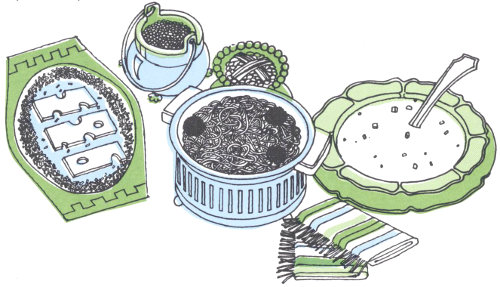
| Food | Weight Pounds | Temperature Setting Degrees | Approx. Cooking Time Hours | Maximum Holding Time Hours |
|---|---|---|---|---|
| Rolled Rib Beef Roast, Medium | 4 | 325 | 2½-3 | 4 |
| Leg of Lamb Roast, Well Done | 6 | 325 | 3½ | 4 |
| Loin End Pork Roast | 5 | 325 | 4 | 4 |
| Cured, Whole Ham | 12 | 325 | 3½ | 4 |
| Veal Loin Roast | 5 | 325 | 3 | 4 |
| Meat Loaf, Well Done | 3 | 350 | 1½ | 3 |
| Chicken, Stuffed | 3½-4½ | 325 | 3-3½ | 3 |
| Baked Fish, Stuffed | 2½-3½ | 400 | 45 min. | 2 |
| Ham Slice With Raisin Sauce | 350 | 1 | 3 | |
| Stuffed Pork Chops | 350 | 1½ | 3 | |
| Swiss Steak (covered) | 350 | 1½ | 4 | |
| Glazed Carrots and Onions (covered) | 350 | 1½ | 3 | |
| Scalloped Potatoes (covered) | 350 | 1½ | 3 | |
| Stewed Tomatoes | 350 | 1 | 4 | |
| Macaroni and Cheese Casserole | 350 | 45 min. | 3 | |
| Tuna and Noodle Casserole | 400 | 40 min. | 2 | |
| Turkey Casserole | 350 | 25 min. | 3 | |
| Apple Crisp | 375 | 45 min. | 4 | |
| Fudge Pudding | 350 | 1 | 3 | |
Many variables such as size, composition and initial temperature of the meat are often encountered in roasts of the same weight. Therefore, the oven timer settings can only be approximate. For more accurate and unattended meat roasting a meat probe is recommended.
(Complete the meal with Hearts of Lettuce Salad, bread and beverage.)

Slash fat on ham slice and place in shallow baking dish. Spread with mixture of corn sirup, vinegar and dry mustard. Pour water around ham. Bake in Gas oven at 350 degrees for 1 hour. Makes 6 servings.
Place frozen succotash in 10 x 6 x 2-inch baking dish. Sprinkle with salt and chopped onion; dot with butter. Cover. Bake in Gas oven at 350 degrees for 1 hour. Makes 6 servings.
Rinse fruit in warm water. Drain. Place in a 2-qt. baking dish. Add water, sugar and sliced orange. Cover. Bake in Gas oven at 350 degrees for one hour. Makes 8 servings.
(Complete the meal with a Mixed Green Salad, bread and beverage.)
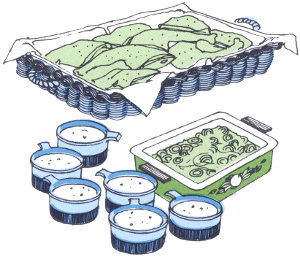
Dip pieces of chicken in milk; roll in mixture of crumbs, parsley, paprika, salt and pepper. Place chicken pieces, skin-side up, in shallow baking pan lined with aluminum foil; do not crowd. Bake in Gas oven at 350 degrees for 1 hour.
Scrape carrots; cut into ¼-inch rings. Place carrots in buttered 10 x 6 x 2-inch baking dish. Combine melted butter, brown sugar, Tabasco sauce, salt and pepper; pour over carrots. Cover with lid or aluminum foil. Bake in Gas oven at 350 degrees for 1 hour. Just before serving, stir in prepared mustard. Makes 6 to 8 servings.
Beat eggs with sugar until light. Add sifted dry ingredients and mix well. Stir in dates and nuts. Turn mixture into a greased 10 x 6 x 2-inch baking dish. Set this dish into a larger pan with ½ inch of water. Bake in Gas oven at 350 degrees for 1 hour. Makes 6 to 8 servings.
(Complete the meal with bread, beverage and ice cream.)
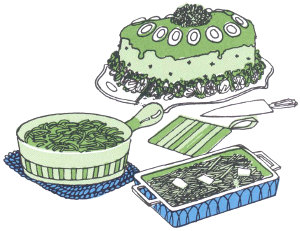
Break bread into small pieces and soak in water. Combine beef with moistened bread, onion, parsley, cheese, egg, salt and pepper. Mix well. Place in 8¾ x 5 x 2½-inch greased loaf pan. Dot with butter. Bake in Gas oven at 375 degrees for 30 minutes. Pour tomato sauce over meat and sprinkle with oregano. Bake 20 minutes longer. Serve hot or cold. Makes 8 servings.
Scrape carrots; cut into ¼-inch rings. Place carrots in buttered 10 x 6 x 2-inch baking dish. Sprinkle with combined salt and pepper; dot with butter. Cover with lid or aluminum foil. Bake in Gas oven at 375 degrees for 50 minutes. Makes 6 to 8 servings.
Drain green beans. Brown bacon. Remove bacon from skillet; crumble. Retain only 2 tablespoons of bacon fat in skillet. Return bacon to skillet. Add green beans, salt and pepper. Mix thoroughly. Place mixture in 1-qt. casserole; cover. Bake in Gas oven at 375 degrees for 50 minutes. Makes 6 to 8 servings.
(Complete the meal with a Lettuce and Tomato Salad, bread and beverage.)

Combine flour, salt, and garlic salt in a paper bag, add the chops and toss lightly until they are thoroughly coated. Heat oil in skillet on thermostatic top burner at 325 degrees; add pork chops and brown. Arrange the chops in a shallow ungreased baking dish without letting them overlap. Sprinkle with basil. Pour apricot nectar around chops. Cover the dish closely with aluminum foil. Bake in Gas oven at 350 degrees for 1 hour. Makes 8 servings.
Drain yams; sprinkle with salt. Cut lemon in very thin crosswise slices. Quarter and core apple; slice into ¼-inch slices. Arrange in two rows lengthwise in 10 x 6 x 2-inch baking dish alternating yams, lemon and apple slices. Place skin side of apple slice up. Combine honey and brown sugar; mix well. Spoon over yam mixture. Dot with butter. Bake in Gas oven at 350 degrees for 1 hour. Makes 8 servings.
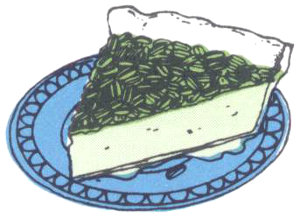
Cream butter; add sugar slowly, creaming until fluffy. Slowly stir in corn sirup, eggs, vanilla and pecans. Pour into pie shell and bake in Gas oven at 350 degrees for 1 hour. Cool. Serve with whipped cream, if desired.
(Complete the meal with a bread, beverage and fruit dessert.)
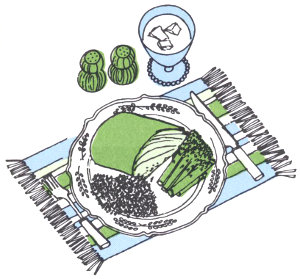
Drain salmon, remove skin and bones; flake. Combine all ingredients. Mix thoroughly. Place in greased 9 x 5 x 3-inch loaf pan. Bake in Gas oven at 350 degrees for 1 hour. Makes 6 servings.
Melt butter in 2-qt. saucepan on thermostatic top burner at medium flame and 300 degrees. Add onions, garlic and rice. Cook until lightly browned, stirring constantly. Add chicken broth and seasonings and bring to a boil. Pour into 2-qt. casserole, cover and bake in Gas oven at 350 degrees for 1 hour. Stir before serving. Makes 6 servings.
Thaw asparagus just enough to separate. Place in greased 1½-qt. casserole. Add seasonings and onion to melted butter and pour over asparagus. Cover and bake in Gas oven at 350 degrees for 1 hour. Makes 6 servings.
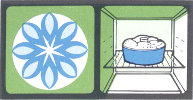
Pan dark or heavy (use shiny cooky sheet)
Pan too deep or too large
Temperature too low
Too much flour
Pan too deep (invert pan or use cooky sheet)
Oven too full; shuts off proper circulation of heat
Wrong type of pans used. Granite or heavy black pans will cause this.
Pans placed too close to oven bottom
Pans placed too close together
Too much dough in pan
Too little leavening
Batter overbeaten
Pan too large
Temperature too high
Ingredients not at room temperature
Too much flour
Temperature too high
Batter undermixed
Too little leavening
Too much liquid
Temperature too low
Egg yolks underbeaten
Too much shortening, liquid or sugar
Too much leavening
Insufficient or too slow baking
Pan too small
Not enough shortening
Overmixing after adding flour
All-purpose flour used
Pans not staggered in oven
Batter uneven in pan
Warped pans
Range not level
Pans touching sides of oven or each other
Pan greased
Too much sugar
Insufficient baking
Oven too full
Oven too hot
Pans too close to sides of oven
Oven too hot
Too thick batter (If cake flour not used, decrease quantity about ¼ to ½ C. or increase liquid ¼ C.)
Cookie sheet set too high in oven
Uneven heat distribution in oven. See that vent is unobstructed
Cookie sheet set on too low a rack in oven
Cookie sheet too wide or too long for oven
Uneven distribution of heat in oven
Overmixing
Pastry stretched in pan
Too much water
Pastry not pricked enough
Temperature too low at start of baking
Filling too juicy
A glass pan or old dull or dark pan will give a browner, crisper undercrust
Avoid shiny tin or glossy aluminum pans for pies
Do not reduce temperature 25 degrees for pie when using oven glass, as you do when baking a cake
Chill unbaked crust before adding filling for custard or pumpkin pies
Temperature too high
Pans touching each other or oven wall
Edge of crust too thin
Granite or black metal pan may cause scorching
Oven not hot enough
Oven too full cutting off circulation of air
Brush top with milk or cream
Shiny tin or aluminum pan may cause this problem
Filling too thin—soaking bottom pastry
Temperature too low

Broiling is a fast method of cooking. It is smokeless because the broiler flame literally consumes any smoke formed. It is cool because it is done with the oven and broiler compartment doors closed.
There are no set rules for broiler cooking time because foods vary, personal preferences differ and broiler burners vary in speed and performance characteristics according to type.

Always broil with full flame unless otherwise specified in recipe. If recipe requires low flame, preheat on full flame first; then lower flame to about 325 degrees to broil food. When preheating, remove the broiler pan from the broiler compartment. Preheat broiler 5 to 10 minutes. This speeds up broiling and gives browner and juicier meats. If broiler is not preheated, allow a few extra minutes on the broiling time.
Do not use aluminum foil on the broiler insert, for it will block the insert openings and prevent drainage of fat and drippings.
Allowances must be made for broiling large quantities of meat at one time by lowering broiler pan position.
Meat for broiling should be tender, but need not be expensive. Hamburgers, weiners, etc. are tasty when broiled.
Veal and fresh pork should not be broiled. Veal is too lean. Pork requires long, slow cooking to be eaten safely.
Always turn meat with tongs, as piercing it with a fork will cause unnecessary loss of meat juices.
Allow meat to brown well on the first side before turning it.
When turning meat, place on its original spot to cover the greasy area and prevent unnecessary charring on the pan insert.
Although it is possible to broil frozen meat, a better product is obtained by thawing before broiling. However, if frozen, increase distance from the burner and allow more time than the chart indicates.
In a Gas range that has a broiler below the oven, it is possible to bake and broil at the same time. Ham, fish, chicken, sandwiches, cold cuts and fruit are just a few of the foods than can be broiled using a low flame. Broiling time will be lengthened by this method. Meat will have a less crusty surface but will be tender and juicy.
Remove broiler pan before preheating. Use high flame for preheating and cooking. Preheat 5 minutes.
| FOOD | DONENESS | DESCRIPTION | INCHES BETWEEN TOP OF FOOD AND FLAME | MINUTES BROILING TIME TURNING ONCE | |
|---|---|---|---|---|---|
| MEAT | |||||
| Bacon | Crisp | Regular sliced | 5 | 5 | |
| Ham | ½ inch slice | 6 | 10 | ||
| Hamburger | Medium | ½ inch | 6 | 8 | |
| Well-done | ½ inch | 6 | 10 | ||
| Hot Dogs | Scored diagonally | 8 | 3 | ||
| Lamb Chops | Medium | 1 inch | 5 | 10 | |
| Well-done | 1 inch | 6 | 16 | ||
| Liver | Well-done | ¼ inch | 5 | 7 | |
| Steak, cube | Medium | ¼ inch | 3 | 4 | |
| Steak | Rare | 1 inch | 4 | 8 | |
| Well-done | 1 inch | 4 | 10 | ||
| Rare | 1½ inches | 5 | 12-14 | ||
| Well-done | 1½ inches | 5 | 18 | ||
| Rare | 2 inches | 6 | 25 | ||
| Well-done | 2 inches | 6 | 30 | ||
| FISH | |||||
| Fillets | ½ inch | 7 | 10 | ||
| 1 inch | 9 | 12 | |||
| Lobster | 3 ounces | 6 | 10 | ||
| 7 ounces | 9 | 20 | |||
| Shrimp | Medium size | 5 | 5 | ||
| POULTRY | |||||
| Chicken | Halves or Breast | 9 | 20 | ||
Food that has been cooked, reheats exceptionally well in the infrared broiler. Preheat as usual. Use High flame. Turning is optional.
Food should be at room temperature, if possible. Brush fruits and vegetables with butter.
Varies with thickness and quantity of food. Hamburger, chops, chicken and seafood reheat successfully at the same distance and time required when originally cooked.
Roasted meat, sliced ¼-inch thick, reheats successfully 3 inches from the flame in 2 to 3 minutes. Turning is not necessary.

| Food | Thickness | Inches between Top of Food and Flame | Broiling Time Turning Once (minutes) | |
|---|---|---|---|---|
| Bacon | Thin Slices | 3-5 | 5 (no turning) | |
| Meat Patties | 1 in. patties | 2-3 | ||
| Medium | 8-12 | |||
| Well-done | 12-20 | |||
| Liver | ½ to ¾ in. | 3 | 6-10 | |
| Lobster | 4-5 | 20-25 | ||
| Fruit (Grapefruit, tomato or peach halves) | 3-4 | 5-10 (no turning) | ||
Steak is probably the most popular meat in America and certainly there is nothing more hearty or satisfying than a good steak, thick and juicy, and sizzling hot right from the broiler.
Figure ¾ to 1 pound of steak per person. It should be at least 1-inch thick. Trim away excess fat and slash remaining edge of fat to prevent curling.
To test a thick steak for doneness, make a small cut with a sharp knife near the bone.
When steak is done as desired, season with salt and pepper, spread with softened butter and serve on a hot platter.
The distance from the flame depends upon thickness of the meat and doneness preferred—the rarer the steak, the nearer to the flame. Broil until nicely browned; turn and finish cooking the second side.
PREHEAT BROILER COMPARTMENT 5 TO 10 MINUTES FLAME-HIGH
RARE: Place so top of meat is 1½ to 2 inches from flame. Broil 8 to 10 minutes, turning once.
MEDIUM: Place so top of meat is 2 to 3 inches from flame. Broil 12 to 18 minutes, turning once.
WELL-DONE: Place so top of meat is 3 to 5 inches from flame. Broil 20 to 25 minutes, turning once.
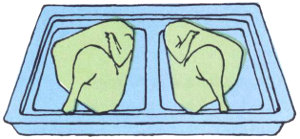
Preheat broiler compartment 5 to 10 minutes. Select 1½ to 2-lb. chicken for broiling. Split in half lengthwise. Break the wing, hip and leg joints to keep chicken flat. Season with salt and pepper. Arrange chicken skin side down on cold broiler pan. Brush with melted butter or margarine, if desired. Broil on the first side until brown, about 15 minutes; turn skin side up and broil until done. Total broiling time varies from 35 to 50 minutes. One chicken makes 2 to 3 servings.
Conventional Broiler:
DISTANCE—5 TO 8 INCHES
FLAME—HIGH
Infrared Broiler:
DISTANCE—8 TO 9 INCHES
FLAME—HIGH

Preheat broiler compartment 5 to 10 minutes. Arrange fish fillets or steaks on cold broiler pan insert. Place fillets skin side down. Dot with butter or margarine and sprinkle with salt and paprika. Broil without turning until golden brown and fish flakes easily when tested with a fork, 10 to 13 minutes.
1½ lb. fish makes 4 to 6 servings.
Conventional Broiler:
DISTANCE—4 INCHES
FLAME—HIGH
Infrared Broiler:
DISTANCE—9 INCHES
FLAME—HIGH
Preheat broiler compartment 5 to 10 minutes. Have ham steak cut ¾ to 1-inch thick. Slash edges of fat to prevent curling. Place ham on cold broiler pan insert. Broil 10 to 20 minutes, depending on thickness of ham, turning once.
Conventional Broiler:
DISTANCE—3 TO 5 INCHES
FLAME—HIGH
Infrared Broiler:
DISTANCE—5 INCHES
FLAME—HIGH
Have butcher cut pocket in steaks. Cook onion and mushrooms in 2 tablespoons butter in skillet on thermostatic top burner at 212 degrees for 5 minutes. Add parsley, lemon juice and salt and pepper to taste. Lightly season pockets with additional salt and pepper; fill with 2 tablespoons mushroom mixture. Secure with a wooden tooth pick. Place in preheated Gas broiler about 3 inches from high flame. Broil 5 minutes or until nicely browned; turn and broil 2 to 3 minutes longer. Garnish with softened butter and serve immediately. Makes 4 servings.
Combine first 7 ingredients, mix well. Brush bread with butter on one side only. Spread the buttered side of each slice of bread evenly with ¼-inch layer of corned beef mixture. Place in preheated Gas broiler about 7 to 9 inches from high flame. Broil about 5 minutes. Press 2 halves together. Serve immediately. Makes 4 sandwiches.
Place ground beef in medium size mixing bowl. In small bowl combine tomatoes, bread crumbs, salt, pepper, onion and parsley. Add combined ingredients to beef and toss lightly with a fork. Form mixture into a large patty, 6 × 6 × 1 inches in the center of a 12-inch square of aluminum foil. Fold exposed 3-inch edge of foil underneath to fit size of meat patty. Place in preheated Gas broiler about 3 inches from high flame. Broil about 6 minutes or until nicely browned; turn meat with pancake turner and remove foil. Broil about 6 minutes on second side. Remove meat from broiler; top with cheese. Cut into squares. Makes 6 servings.
Slice cake into four ½-inch lengthwise layers; lay cake layers in bottom of broiler pan. Spread sour cream evenly over top of each layer; sprinkle with brown sugar. Using a spatula, swirl top of the mixture to slightly blend the cream and sugar. Place in preheated Gas broiler about 7 to 9 inches from high flame. Broil 6 to 7 minutes. Make two separate cakes, placing one layer on top of another, keeping cream and sugar side up. Cut each cake crosswise into 3 servings. Using 1 pint of berries, garnish the top of each serving. Pour strawberry glaze over berries on cake. Serve immediately. Makes 6 servings.
Wash, drain and hull strawberries; crush. If necessary add enough water to make 1½ cups. Place strawberries and juice in saucepan on thermostatic top burner at medium flame and 212 degrees; gradually stir in mixture of sugar, cornstarch, and salt. Bring to boiling, boil 1 minute, stirring constantly. Cool. Pour over berries on cake. Makes 6 servings.
NOTE: This glaze should be made in advance and cooled before broiling the cake.

Foods cooked on the rotisserie require little attention because they rotate slowly, basting themselves to achieve flavor and appearance.
It is best to bring meat to room temperature before cooking.
Before preheating, check to see that food on rotisserie spit is centered under the burner and rotating evenly. Reposition food if necessary.
For most accurate test of doneness, use a meat thermometer. It will indicate internal temperature which is more accurate than estimating time. Insert carefully so thermometer does not touch fat, bone or rotisserie spit, or hit any part of compartment when meat is rotating.
Bones and fat are both good conductors of heat, so roasts which have larger amounts will cook more quickly than lean boneless pieces.
Smaller pieces of meat require a longer cooking time per pound than large pieces of meat.
Season the cavity of poultry before cooking. Stuff if desired. Tie wings and legs close to body before securing firmly on rotisserie spit. Season skin. Brushing with butter is not necessary.
When using High flame, baste only during the last 10 minutes of cooking. When a longer basting period is desired, it is best to use Low flame.
To make a roast carve more easily, allow the meat to “set” after cooking. Rare roasts should be covered loosely and allowed to stand in a Gas oven at 170 degrees for 20 to 30 minutes before carving. The medium and well-done roasts should be allowed about half this much time.
Consult manufacturer’s instruction booklet for specific information. The following is intended only as a guide.
The rotisserie may be located in the oven, broiler or on top of the range. FOR ROTISSERIE LOCATED IN OVEN, FOLLOW TIME AND TEMPERATURE GIVEN IN OVEN MEAT ROASTING GUIDE.
In built-in ranges with rotisserie located in broiler compartment under oven, set oven thermostat at 350 degrees for low flame; at “broil” for high flame. Keep door closed as for broiling.
Preheat 10 minutes.
| FOOD | WEIGHT POUNDS | FLAME SETTING FOR ROTISSERIE | MINUTES PER POUND | ||
|---|---|---|---|---|---|
| BEEF | |||||
| Rolled Rib | 4-6 | In Broiler—Low | Rare | 26-30 | |
| Medium | 35-40 | ||||
| Well-done | 40-45 | ||||
| Tenderloin | 2½-3 | In Broiler—medium | Rare | 10-15 | |
| Medium | 15-20 | ||||
| Well-done | 22-28 | ||||
| LAMB | |||||
| Rolled Leg | 4-5 | In Broiler—low | ... | 40-45 | |
| PORK | |||||
| Canadian Bacon | 3-4 | In Broiler—low | ... | 20-25 | |
| Ham-cured | 3-4 | In Broiler—low | ... | 35-40 | |
| Ham-precooked | 4 | In Broiler—low | ... | 20 | |
| Loin, fresh (boned and rolled) use meat thermometer to make sure that pork roasts are well-done. | 3-5 | In Broiler—low | ... | 45-55 | |
| FOOD | WEIGHT POUNDS | FLAME SETTING FOR ROTISSERIE | COOKING TIME | ||
|---|---|---|---|---|---|
| Spareribs | In Broiler—low | 1½-2 | hours | ||
| Weiners | In Broiler—medium | 12-15 | min. | ||
| POULTRY | |||||
| Chicken (halved) | 2-3 | In Broiler—low | 1-1¼ | hours | |
| Chicken (whole) | 2-3 | In Broiler—medium | 1¼-1½ | hours | |
| Cornish Hen | ¾-1 | In Broiler—low | 1½-2 | hours | |
| Duckling | 4-5 | In Broiler—low | 2½-3 | hours | |
Use High flame for preheating and cooking
Preheat 5 minutes
| FOOD | WEIGHT POUNDS | DONENESS | MINUTES PER POUND | INTERNAL TEMPERATURE | |
|---|---|---|---|---|---|
| BEEF | |||||
| Rolled Rib | 4-6 | Rare | 20 | 140°F. | |
| Medium | 22 | 160°F. | |||
| Well-Done | 25 | 170°F. | |||
| Rib Eye Roast | 3-4 | Rare | 20 | 140°F. | |
| Medium | 22 | 160°F. | |||
| Well-Done | 25 | 170°F. | |||
| LAMB | |||||
| Rolled Leg | 3-4 | Medium | 25 | 175°F. | |
| PORK | |||||
| Canadian Bacon | 2-3 | Well-Done | 20 | 170°F. | |
| Ham—Ready-to-Eat | 5-6 | Well-Done | 20 | 160°F. | |
| Loin—Bone In | 4-5 | Well-Done | 15 | 170°F. | |
| POULTRY | |||||
| Broiler-fryer | 2-3 | Well-Done | 20 | 190°F. | |
| Turkey (not stuffed) | 6-8 | Well-Done | 15 | 190°F. | |

Note: See pages 12 through 18 to use thermostatic top burner for these methods.
To cook in a liquid at a temperature of 212 degrees. Visually, bubbles should rise continually. Method: cover the pan and bring the contents to a boil over a high flame. Then turn to the simmer flame (first click on many burners) and continue boiling, covered until done.
To cook meat or poultry by searing in fat, then simmering in a covered pan in small amount of moisture. Method: generally, meats are seasoned and rolled in flour and browned in hot fat. Then add a small amount of liquid and cover the pan. Turn burner valve knob to simmer flame, so food simmers, not boils, until done.
To cook in fat deep enough to completely cover the food being cooked. A saucepan or skillet may be used. Method: use a high flame to bring the fat to frying temperature (usually 375 degrees), then lower the flame until it just maintains the desired fat temperature.
This term is used to describe a vigorous, rolling boil which cannot be stirred down. It cooks no faster than a gentle boil but is needed for cooking foods like macaroni or jellies and jams. Method: cover the pan and use a high flame to bring the contents to a boil quickly. Then uncover the pan and turn to a medium flame or enough heat to maintain a high boil. The food is cooked uncovered in this case to prevent boil-overs and/or to permit evaporation.
To liquify a solid food by heat. Method: heat over “keep warm” flame until liquified. Covering the pan will speed melting.
To cook uncovered on a hot surface, usually in a skillet, pouring off fat as it accumulates. Method: heat skillet on “high”. Do not add fat or water and do not cover. Turn to “simmer” and brown meat slowly on both sides, pouring off fat as it accumulates.
To cook uncovered in a hot skillet in a small amount of fat. Method: heat just enough fat or butter to keep the meat from sticking (one to four tablespoons) in a skillet over a low to medium flame, depending on the utensil material. Add the food to the hot fat and cook, turning occasionally, until brown as desired.
To cook in liquid, usually water, at a temperature below the boiling point. Small bubbles are formed and rise slowly, but the liquid is practically motionless. Method: cover the pan and bring the food to the boiling point over a high flame. Then turn to the “simmer” flame.
To cook foods slowly in a covered pan in enough water to cover the food. Method: this is the same as braising except that more liquid is used. The food should simmer, not boil.

1. Always sift cake and all-purpose flour before measuring. Sift pre-sifted flour unless recipe specifically says otherwise. Do not sift rye, graham or whole wheat flour. Instantized flour cannot be sifted.
2. Sift onto waxed paper. Spoon lightly into dry measuring cup, being careful not to pack or shake it. Level with straight-edged spatula, without packing down.
1. Always set liquid measuring cup on level surface and fill to desired mark.
2. If thick like molasses or sirup, level off with spatula.
Use graduated measuring cups. Have shortening at room temperature. Pack firmly into measuring cup. Level off with straight-edged spatula.
Use graduated measuring cup. Pack down in cup with back of spoon, just enough to hold together when turned out.
One stick (¼ lb.) equals ½ cup. To measure ¼ cup, cut stick in half. 1 Tbsp. equals ⅛ of a stick. Do not substitute whipped margarine or butter unless recipe specifically calls for it.
Pack raisins, dates, figs, etc. lightly into measuring cup. Press gently to level off top.
Pack lightly into cup and level off.
Pack lightly into measuring cup. Do not press down hard. Level off.
Spoon lightly into measuring cup and level off. Don’t shake cup.
Pack lightly into measuring cup and level off.
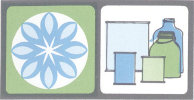
| CAN SIZES | ||
|---|---|---|
| Size of Cans | Weight | Cups Per Can |
| 8 oz. can | 8 oz. | 1 C. |
| Picnic can (No. 1) | 10½ oz. | 1¼ C. |
| 12 oz. can | 12 oz. | 1½ C. |
| No. 300 can | 14 to 16 oz. | 1¾ C. |
| No. 303 can | 16 to 17 oz. | 2 C. |
| No. 2 can | 1 lb., 4 oz. or 1 pt., 2 fl. oz. | 2½ C. |
| No. 2½ can | 1 lb., 13 oz. | 3½ C. |
| No. 3 can | 3 lb., 3 oz. or 1 qt., 14 fl. oz. | 5¾ C. |
| No. 10 can | 6½ to 7 lb., 5 oz. | 12 to 13 C. or 3¼ qt. |
| Ingredients | Quantity | Substitute(s) |
|---|---|---|
| BAKING POWDER | 1 teaspoon double-acting | 1½ teaspoons phosphate or tartrate baking powder |
| ¼ teaspoon baking soda plus ½ cup buttermilk or sour milk | ||
| ¼ teaspoon baking soda plus ⅝ teaspoon cream of tartar | ||
| BUTTER | 1 cup | 1 cup margarine |
| ⅞ to 1 cup hydrogenated fat plus ½ teaspoon salt | ||
| ⅞ cup lard plus ½ teaspoon salt | ||
| CHOCOLATE | 1 square unsweetened | 3 tablespoons cocoa plus 1 tablespoon shortening |
| CORNSTARCH (for thickening) | 1 tablespoon | 2 tablespoons flour (approx.) or 4 teaspoons quick-cooking tapioca |
| CORN SIRUP | 1 cup | 1 cup sugar plus ¼ cup liquid (as replacement for ½ of sugar in recipe) |
| CREAM | 1 cup coffee cream (20% milk fat) | 3 tablespoons butter plus ⅞ cup milk |
| 1 cup heavy cream (40% milk fat) | ⅓ cup butter plus ¾ cup milk | |
| EGGS | 1 whole egg | 2 egg yolks |
| FLOUR (for thickening) | 1 tablespoon | ½ tablespoon cornstarch 2 teaspoons quick-cooking tapioca |
| FLOUR (sifted) | 1 cup all-purpose | 1 cup plus 2 tablespoons cake flour |
| 1 cup cake flour | ⅞ cup all-purpose flour | |
| HERBS | 1 tablespoon fresh | 1 teaspoon dried |
| HONEY | 1 cup | 1 to 1¼ cups sugar plus ¼ cup liquid |
| MILK | 1 cup fresh milk | 1 cup reconstituted non-fat dry milk plus 2 teaspoons butter |
| 1 cup whole milk | ½ cup evaporated milk plus ½ cup water | |
| 1 cup sour milk | 1 tablespoon lemon juice or vinegar plus sweet milk to make 1 cup | |
| 1¾ teaspoons cream of tartar plus 1 cup sweet milk | ||
| YEAST | 1 cake compressed | 1 package or 2 teaspoons active dry yeast |

COLUMBIA GAS SYSTEM
HSR-67